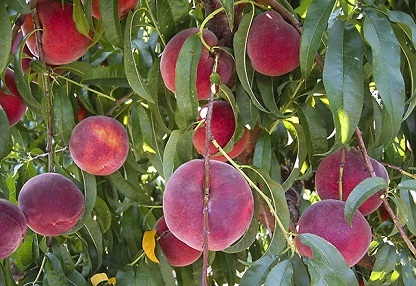The Chronicles Of Grant County
 Peaches ripening on trees in Byron, Georgia. (The photograph was produced by Chunxian Chen and provided courtesy of the Agricultural Research Service of the USDA.)
Peaches ripening on trees in Byron, Georgia. (The photograph was produced by Chunxian Chen and provided courtesy of the Agricultural Research Service of the USDA.)
Peach Street is a road in the City of Deming in Luna County. The street was named after the Peach tree.
The Agricultural Research Service of the United States Department of Agriculture (ARS of the USDA) indicated that there are more than 2,000 varieties of peaches.
Georgia is one of a number of states where peaches are grown in the United States.
"Though peaches were originally planted in St. Augustine, Florida, Franciscan monks introduced them to St. Simons and Cumberland islands along Georgia's coast in 1571," according to a statement from the Georgia Peach Council. "The first Georgia peaches were shipped to the New York market between 1858 and 1860."
While Georgia is known by many as the "Peach State," statistics from the USDA noted that more peaches are actually produced in California and South Carolina than in Georgia.
The USDA indicated that there are two main types of peaches – clingstone peaches and freestone peaches. In the first example, the flesh of a peach "clings" to the "stone" of that peach; in the second example, the "stone" separates "freely" from the flesh of a peach.
The flesh of a peach itself, noted the USDA, typically comes in one of three different colors: red, white, and yellow. This Federal agency indicated that in the U S, yellow is the most common color of peach flesh.
The ARS of the USDA reported that eating peaches is one of its top ten tips for healthy eating.
"Like many fruits, peaches are a good source of fiber, vitamins, and minerals, specifically vitamins C, A, E and K," according to a statement from the ARS of the USDA. "These nutrients help fight disease and help build healthy eyes and bones."
"Peaches boast lots of potential health benefits, including aiding digestion, reducing allergy symptoms, and improving heart health," the statement continued. "The fruit is power-packed with antioxidants and has anti-inflammatory properties. Peaches are a terrific snack when you want something sweet and juicy."
Fuzz on a peach is a protective device for the fruit.
"The fuzz is a defense mechanism designed to help protect the peaches from insects, disease, even poor weather while they grow on trees," according to the ARS of the USDA.
Commercial growers of peaches need to be especially concerned about how weather conditions can affect their peach crops.
When Spring-like weather arrives early – before the last frost – flowers on peach trees can start to bloom. If a cold snap then occurs, it's possible that the affected trees will lose some or all of that upcoming season's fruit.
To minimize that risk, some farmers have employed the services of helicopters to fly low over peach orchards.
The key to protecting these fruit trees is to break the barrier caused by an inversion. The Arizona Department of Environmental Quality described an inversion as an atmospheric condition "…when a layer of cooler air is trapped near the ground by a layer of warm air above the surface."
By utilizing a helicopter, the rotors of the aircraft help to push warmer air down to the ground in an effort to dissipate the colder air and thereby raise ambient air temperatures around the peach trees.
The critical temperature seems to be 28 degrees Fahrenheit for the survival of buds on peach trees. Temperatures below that can cause the buds to die.
Research done by two professors at Auburn University provided some detailed analysis on how and when this type of technology works best.
"Helicopters provide good protection when moderate to strong inversions are present," according to a report of that research issued by the Alabama Cooperative Extension Service in October of 2000.
"One helicopter can protect about 50 to 100 acres, although some growers have tried to use one for 100 to 200 acres," the report noted. "Under rather cold conditions, a helicopter must cover the same area every 30 to 60 minutes to maintain temperatures above critical levels."
The report indicated that "once the helicopter locates the strongest inversion, usually at 75 to 150 feet, it flies at this level at 15 to 25 mph to thoroughly mix the air. Some have tried flying at 50 mph or greater, but little beneficial effort has been felt. When helicopters hover slowly over trees, temperatures can rapidly increase 5 to 8 degrees."
Do you have questions about communities in Grant County?
A street name? A building?
Your questions may be used in a future news column.
Contact Richard McDonough at chroniclesofgrantcounty@mail.com.
If your email does not go through, please contact editor@grantcountybeat.com.
© 2023 Richard McDonough


